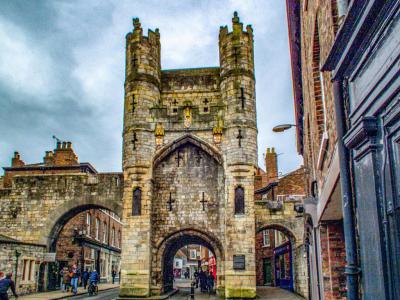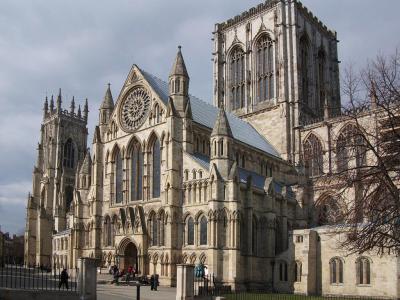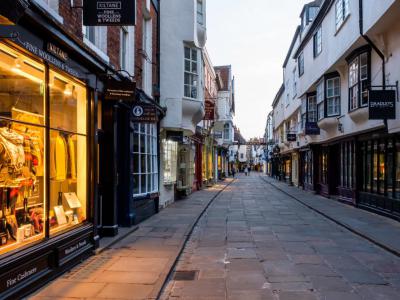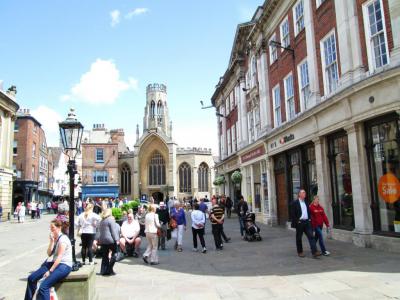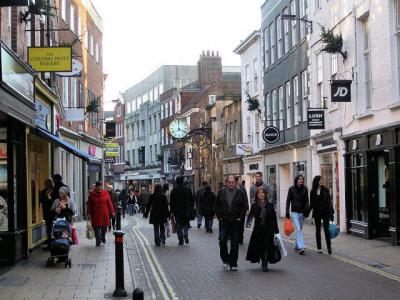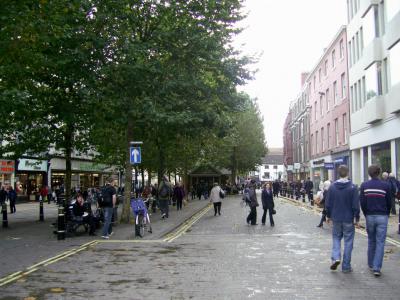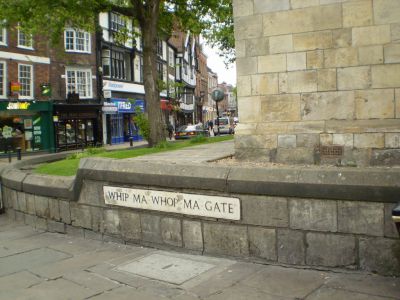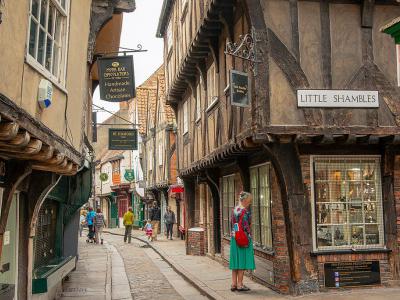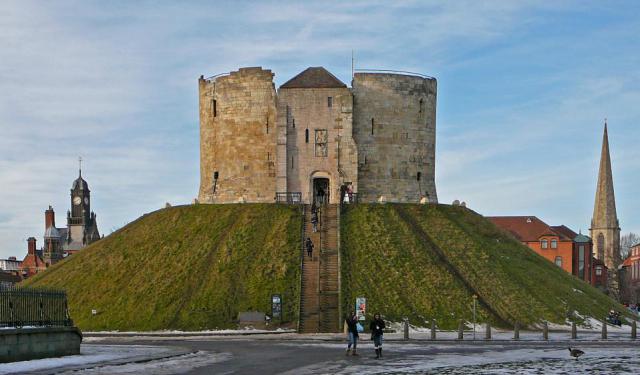York's Old Town (Self Guided), York
A vibrant city with Roman roots and a Viking past, York has played a central role throughout much of England‘s history. Despite its small size, Old Town York boasts a wealth of colorful heritage that draws tourists in droves from all over the world.
The maze of historic streets – too narrow for vehicles, and therefore solely pedestrian – are packed with attractions fairly close to one another, which makes it a great place to explore on foot. With an array of quirky little details around and the ancient traditions hung in the air, it surely feels like walking back in time. Just make sure to wear some comfortable shoes!
To make a trip through the old capital of England’s north a little easier, here some of the essential stops to make along the way:
The Shambles – a medieval street, one of York’s oldest; formerly a meat market lined with butcher shops, hence the name. The buildings have a typical overhang of that period.
York Minster – the second-largest Gothic cathedral in Northern Europe and one of the tallest buildings in the city, as prescribed by the ancient local law.
Stonegate – among the most visited streets in downtown York, with most buildings listed as architecturally or historically important.
Parliament Street – a focal point and major shopping hub; mostly pedestrianized since the 1980s.
Whip-Ma-Whop-Ma-Gate – one of, if not the, smallest street in York; the name means "What a street!" or, the latest version, "Neither one thing nor the other".
If you're keen to have an unparalleled and pristine glimpse into the UK of a bygone era and to explore the attractions York’s Old Town so proudly displays, take this self-guided tour.
The maze of historic streets – too narrow for vehicles, and therefore solely pedestrian – are packed with attractions fairly close to one another, which makes it a great place to explore on foot. With an array of quirky little details around and the ancient traditions hung in the air, it surely feels like walking back in time. Just make sure to wear some comfortable shoes!
To make a trip through the old capital of England’s north a little easier, here some of the essential stops to make along the way:
The Shambles – a medieval street, one of York’s oldest; formerly a meat market lined with butcher shops, hence the name. The buildings have a typical overhang of that period.
York Minster – the second-largest Gothic cathedral in Northern Europe and one of the tallest buildings in the city, as prescribed by the ancient local law.
Stonegate – among the most visited streets in downtown York, with most buildings listed as architecturally or historically important.
Parliament Street – a focal point and major shopping hub; mostly pedestrianized since the 1980s.
Whip-Ma-Whop-Ma-Gate – one of, if not the, smallest street in York; the name means "What a street!" or, the latest version, "Neither one thing nor the other".
If you're keen to have an unparalleled and pristine glimpse into the UK of a bygone era and to explore the attractions York’s Old Town so proudly displays, take this self-guided tour.
How it works: Download the app "GPSmyCity: Walks in 1K+ Cities" from Apple App Store or Google Play Store to your mobile phone or tablet. The app turns your mobile device into a personal tour guide and its built-in GPS navigation functions guide you from one tour stop to next. The app works offline, so no data plan is needed when traveling abroad.
York's Old Town Map
Guide Name: York's Old Town
Guide Location: England » York (See other walking tours in York)
Guide Type: Self-guided Walking Tour (Sightseeing)
# of Attractions: 8
Tour Duration: 1 Hour(s)
Travel Distance: 1.3 Km or 0.8 Miles
Author: val
Sight(s) Featured in This Guide:
Guide Location: England » York (See other walking tours in York)
Guide Type: Self-guided Walking Tour (Sightseeing)
# of Attractions: 8
Tour Duration: 1 Hour(s)
Travel Distance: 1.3 Km or 0.8 Miles
Author: val
Sight(s) Featured in This Guide:
- Monk Bar
- York Minster
- Stonegate
- Saint Helen's Church and Square
- Coney Street
- Parliament Street
- Whip-Ma-Whop-Ma-Gate
- The Shambles
1) Monk Bar
A bar is a gate in the medieval England - the word "bar" has its origin in barries. Monk Bar is ranked as the tallest and most elaborate of York's surviving medieval city gates. It was constructed in the early 14th century as a self-contained fortress, with each floor capable of being separately defended.
On the front of the bar is an arch supporting a gallery, including "murder-holes" through which missiles and boiling water could be rained down upon attackers. Later, it was used to jail unruly Catholics, and you can experience what it was like for being a "bad Catholic" by squeezing yourself into the cramped Little-Ease Prison tucked away in one of the towers.
Today, Monk Bar houses a fascinating museum dedicated to Richard III and has the only working portcullis in York, complete with spiked railings. Between Monk Bar and Bootham Bar is one of the nicest sections of York City Wall.
On the front of the bar is an arch supporting a gallery, including "murder-holes" through which missiles and boiling water could be rained down upon attackers. Later, it was used to jail unruly Catholics, and you can experience what it was like for being a "bad Catholic" by squeezing yourself into the cramped Little-Ease Prison tucked away in one of the towers.
Today, Monk Bar houses a fascinating museum dedicated to Richard III and has the only working portcullis in York, complete with spiked railings. Between Monk Bar and Bootham Bar is one of the nicest sections of York City Wall.
2) York Minster (must see)
The York Minister is an impressive cathedral with a long and storied history. The Romans settled here and named the area Eboracum in 71 AD. King Edwin was baptized in a small wooden church here in 625. A stone church was built, and King Edwin was buried in the stone church in 633. In 1088, a new Minister was built. The Minister was expanded between 1154 and 1225. In 1328, the York Minister hosted a royal wedding between King Edward III and Philippa of Hainault.
Richard Scrope, Archbishop of York, was accused of treason by Henry IV and beheaded in 1405. His tomb lies in the Minister.
The Minister as it stands today was completed in 1471. It is the second-largest Gothic cathedral in Northern Europe. The name "minister" harkens to Anglo-Saxon missionary churches. The cathedral's official name is the Cathedral and Metropolitical Church of Saint Peter in York.
The Minister features majestic architecture, including a Gothic nave and a Perpendicular Gothic quire. The 1408 Great East Window is the largest expanse of stained glass in the world. Each lancet in the magnificent Five Sisters Window is 53 feet tall. A gorgeous rose window graces the south transept. The design of the west window is known as The Heart of Yorkshire.
The transepts feature wooden roofs. The nave was completed in 1350 and is England's widest Gothic nave. The central tower is 235 feet tall (72 meters). The choir is 102 feet tall (31 meters). The octagonal Chapter House was built in 1280 and features wonderful stone carvings.
Visitors can view the remains of the Roman fort in the cathedral's museum.
Why You Should Visit:
The York Minister is one of the most impressive churches in Northern Europe. It was one of the few Catholic churches not destroyed by Henry VIII, as he wanted to convert it to an Anglican church. The soaring nave, impressive towers, storied history, and Gothic architecture are the highlight of any York visit.
Tips:
Go for an evensong service, usually held in the evenings at 5:15 pm, and experience the acoustic wonders of the choir and organ.
The 35 church bells ring at 10:00 am on Sundays.
Richard Scrope, Archbishop of York, was accused of treason by Henry IV and beheaded in 1405. His tomb lies in the Minister.
The Minister as it stands today was completed in 1471. It is the second-largest Gothic cathedral in Northern Europe. The name "minister" harkens to Anglo-Saxon missionary churches. The cathedral's official name is the Cathedral and Metropolitical Church of Saint Peter in York.
The Minister features majestic architecture, including a Gothic nave and a Perpendicular Gothic quire. The 1408 Great East Window is the largest expanse of stained glass in the world. Each lancet in the magnificent Five Sisters Window is 53 feet tall. A gorgeous rose window graces the south transept. The design of the west window is known as The Heart of Yorkshire.
The transepts feature wooden roofs. The nave was completed in 1350 and is England's widest Gothic nave. The central tower is 235 feet tall (72 meters). The choir is 102 feet tall (31 meters). The octagonal Chapter House was built in 1280 and features wonderful stone carvings.
Visitors can view the remains of the Roman fort in the cathedral's museum.
Why You Should Visit:
The York Minister is one of the most impressive churches in Northern Europe. It was one of the few Catholic churches not destroyed by Henry VIII, as he wanted to convert it to an Anglican church. The soaring nave, impressive towers, storied history, and Gothic architecture are the highlight of any York visit.
Tips:
Go for an evensong service, usually held in the evenings at 5:15 pm, and experience the acoustic wonders of the choir and organ.
The 35 church bells ring at 10:00 am on Sundays.
3) Stonegate
Stonegate in York is a captivating historical thoroughfare nestled in the city's heart cherished both for its architectural merit and profound historical significance. Originally tracing the path of an ancient Roman road between Saint Helen's Square and the majestic York Minster, Stonegate has been a central feature of the city since antiquity.
The significance of Stonegate surged during the 11th century when York Minster was undergoing reconstruction. The street served as a vital route for transporting stone from a nearby quay to the construction site, highlighting its pivotal role in the city's development. The land along Stonegate primarily belonged to York Minster, with the area rapidly developing into a densely populated district of tenements.
By 1119, the street was already known as "Stonegate," a name thought to derive from its unique stone paving. However, another theory suggests the name reflects its historical function in the transportation of building stone to the Minster. Over the centuries, Stonegate evolved into a hub for various trades, including glass painters and goldsmiths in its earlier days, and later became renowned for its printers and bookshops from the 1500s.
Stonegate has also played a crucial role in the civic life of York. It has historically been the route for civic processions between the York Guildhall and York Minster and was a performance site for three of the historic York Mystery Plays. Notably, the street is the birthplace of Guy Fawkes, a figure infamous for his role in the 1605 Gunpowder Plot.
The architectural and cultural richness of Stonegate has been celebrated by British art historian Sir Nikolaus Pevsner, who described it as "perhaps the most attractive street in the city, and one of the busiest." Reflecting its popularity and historical value, Stonegate was pedestrianized and repaved in York stone in 2020, preserving its charm and accessibility for tourists and locals alike.
The significance of Stonegate surged during the 11th century when York Minster was undergoing reconstruction. The street served as a vital route for transporting stone from a nearby quay to the construction site, highlighting its pivotal role in the city's development. The land along Stonegate primarily belonged to York Minster, with the area rapidly developing into a densely populated district of tenements.
By 1119, the street was already known as "Stonegate," a name thought to derive from its unique stone paving. However, another theory suggests the name reflects its historical function in the transportation of building stone to the Minster. Over the centuries, Stonegate evolved into a hub for various trades, including glass painters and goldsmiths in its earlier days, and later became renowned for its printers and bookshops from the 1500s.
Stonegate has also played a crucial role in the civic life of York. It has historically been the route for civic processions between the York Guildhall and York Minster and was a performance site for three of the historic York Mystery Plays. Notably, the street is the birthplace of Guy Fawkes, a figure infamous for his role in the 1605 Gunpowder Plot.
The architectural and cultural richness of Stonegate has been celebrated by British art historian Sir Nikolaus Pevsner, who described it as "perhaps the most attractive street in the city, and one of the busiest." Reflecting its popularity and historical value, Stonegate was pedestrianized and repaved in York stone in 2020, preserving its charm and accessibility for tourists and locals alike.
4) Saint Helen's Church and Square
Saint Helen's Church in York, a Grade II* listed building, boasts a rich history that spans several centuries. Dating back to the 14th century, this parish church in the Church of England experienced a significant period of redundancy in 1551, during which it was partially demolished. Despite these challenges, the church was restored and brought back into service.
Between 1857 and 1858, architect W H Dykes led an extensive reconstruction, which included the rebuilding of the north, south, and east walls, replacement of the church roof, and installation of open seating in place of traditional pews. The chancel was notably rebuilt and extended, improving its structure significantly. Furthermore, advancements such as gas lighting were added to enhance the church’s ambiance.
Saint Helen's Square, an integral part of York's city center, holds historical significance that traces back to the Roman era when it was the site of Eboracum's southwestern gate. Originally part of Saint Helen's Church graveyard, the area was transformed into a public square after the church received new land for a graveyard in 1745, and the old graveyard was paved over.
By the 18th century, Saint Helen's Square had developed into a bustling hub with the York Tavern, established in 1770, serving as a major stagecoach departure point to London. The square also hosted Terry’s shop from 1818, which later expanded to include a restaurant until its closure in 1980. Today, the square is known for its vibrant activities including the annual Christmas tree lighting and various public demonstrations.
The square is surrounded by significant streets and buildings. Notable structures include the Mansion House, the York Guildhall visible through a gateway, and historically important buildings housing entities like Yorkshire Insurance Company and York County Savings Bank. The square's historical and architectural value is further highlighted by several listed buildings such as the former Terry's building and Bettys tea rooms housed in the structures built in 1929.
Together, Saint Helen's Church and Square encapsulate a blend of historical reverence and contemporary vitality, making them key landmarks in York’s cultural and community landscape.
Between 1857 and 1858, architect W H Dykes led an extensive reconstruction, which included the rebuilding of the north, south, and east walls, replacement of the church roof, and installation of open seating in place of traditional pews. The chancel was notably rebuilt and extended, improving its structure significantly. Furthermore, advancements such as gas lighting were added to enhance the church’s ambiance.
Saint Helen's Square, an integral part of York's city center, holds historical significance that traces back to the Roman era when it was the site of Eboracum's southwestern gate. Originally part of Saint Helen's Church graveyard, the area was transformed into a public square after the church received new land for a graveyard in 1745, and the old graveyard was paved over.
By the 18th century, Saint Helen's Square had developed into a bustling hub with the York Tavern, established in 1770, serving as a major stagecoach departure point to London. The square also hosted Terry’s shop from 1818, which later expanded to include a restaurant until its closure in 1980. Today, the square is known for its vibrant activities including the annual Christmas tree lighting and various public demonstrations.
The square is surrounded by significant streets and buildings. Notable structures include the Mansion House, the York Guildhall visible through a gateway, and historically important buildings housing entities like Yorkshire Insurance Company and York County Savings Bank. The square's historical and architectural value is further highlighted by several listed buildings such as the former Terry's building and Bettys tea rooms housed in the structures built in 1929.
Together, Saint Helen's Church and Square encapsulate a blend of historical reverence and contemporary vitality, making them key landmarks in York’s cultural and community landscape.
5) Coney Street
Coney Street is a key shopping area in York's city center. It extends from Spurriergate and Market Street junction to Saint Helen's Square in the northwest. This street dates back to the Roman times in York, known as Eboracum, where it was situated just outside the southwestern city walls. Near its northern end, there was a bridge crossing the River Ouse. Archeological digs have uncovered a grain warehouse from the 1st century on the street’s southwest side.
The earliest mention of the street is around 1150 under the name "Cuningstrete," meaning King's Street. The term "street" is used instead of "gate," indicating it originated in the Anglian period, supported by the discovery of two coin hoards in the 1760s.
By 1308, Coney Street had become York's most important street. In 1335, houses were built in Saint Martin's churchyard, which were repeatedly reconstructed until the final structures were demolished in 1958. The Guild of Saint Christopher Maison Dieu almshouse was built here in 1396, followed by York Guildhall in 1459, near the street’s northern end. Right in front of the Guildhall, the York Mansion House was erected in 1725, and in 1782, the area was cleared to form St Helen's Square.
In the 19th century, Coney Street was filled with shops including notable businesses like the House of Bewlay tobacconist, Burgin's perfumery, and the Leak & Thorp department store. Throughout the 20th century, many of these shops were replaced by national chain stores. Despite several closures in the 2010s, the street continues to host a variety of High Street shops and cafes. It's also a popular spot for buskers who perform there throughout the day.
The earliest mention of the street is around 1150 under the name "Cuningstrete," meaning King's Street. The term "street" is used instead of "gate," indicating it originated in the Anglian period, supported by the discovery of two coin hoards in the 1760s.
By 1308, Coney Street had become York's most important street. In 1335, houses were built in Saint Martin's churchyard, which were repeatedly reconstructed until the final structures were demolished in 1958. The Guild of Saint Christopher Maison Dieu almshouse was built here in 1396, followed by York Guildhall in 1459, near the street’s northern end. Right in front of the Guildhall, the York Mansion House was erected in 1725, and in 1782, the area was cleared to form St Helen's Square.
In the 19th century, Coney Street was filled with shops including notable businesses like the House of Bewlay tobacconist, Burgin's perfumery, and the Leak & Thorp department store. Throughout the 20th century, many of these shops were replaced by national chain stores. Despite several closures in the 2010s, the street continues to host a variety of High Street shops and cafes. It's also a popular spot for buskers who perform there throughout the day.
6) Parliament Street
Parliament Street is a pivotal shopping area in the heart of York, notable for its rich history and vibrant present-day use. Originally a densely built-up area, the site evolved significantly over time. By the 19th century, existing markets at nearby Pavement and St Sampson's Square were overcrowded. In response, York's city corporation opted to clear the area and create Parliament Street to house a new, more spacious market. This new street connected Pavement and St Sampson's Square and began to serve as the city's main marketplace when it opened in 1836.
For nearly a century, Parliament Street thrived as the central market hub of York, holding daily markets with Saturdays designated as the principal market day. This continued until 1955 when the market operations were transferred to the current Shambles Market. Following this, in the latter part of the 20th century, particularly in 1989, a significant redesign competition led to the pedestrianization of Parliament Street. This transformation included maintaining a single carriageway for limited vehicle access while dedicating most of the street to pedestrian use.
Today, Parliament Street is lined with a mix of high-street retail outlets, including a significant branch of Marks & Spencer. The street not only continues to be a shopping destination but also serves as a venue for various cultural and festive events, including temporary markets, enriching its historical marketplace legacy with contemporary urban activities.
For nearly a century, Parliament Street thrived as the central market hub of York, holding daily markets with Saturdays designated as the principal market day. This continued until 1955 when the market operations were transferred to the current Shambles Market. Following this, in the latter part of the 20th century, particularly in 1989, a significant redesign competition led to the pedestrianization of Parliament Street. This transformation included maintaining a single carriageway for limited vehicle access while dedicating most of the street to pedestrian use.
Today, Parliament Street is lined with a mix of high-street retail outlets, including a significant branch of Marks & Spencer. The street not only continues to be a shopping destination but also serves as a venue for various cultural and festive events, including temporary markets, enriching its historical marketplace legacy with contemporary urban activities.
7) Whip-Ma-Whop-Ma-Gate
Whip-Ma-Whop-Ma-Gate is a notable street in York famed for its brief span and distinctive name. Originating from Colliergate, this street extends approximately 80 feet south to intersect with Pavement, Fossgate, and the Stonebow. On its eastern side, it is bordered by Saviourgate. The street also lies adjacent to the historic Saint Crux Parish Hall, which once served as one of York's medieval churches.
The unusual name "Whip-Ma-Whop-Ma-Gate" was first documented in 1505 as Whitnourwhatnourgate and has undergone various transformations, such as Whitney Whatneygate. The name humorously means "neither-one-thing-nor-the-other street," though a plaque suggests it could be interpreted as "what a street!" Historical records from the 17th and 18th centuries refer to it alternatively as Salvey Rents or Salvegate.
The street was notably widened in the 1750s following the demolition of houses built against Saint Crux Church, which itself was dismantled in 1887. Elements of this church, including a Perpendicular window and several monuments, are preserved in the remaining structure of the Saint Crux Parish Room. Part of the church’s north wall is integrated into the structure of No. 23 Shambles, adjacent to Whip-Ma-Whop-Ma-Gate.
In 1984, the alley was repaved with York stone, financed by York Civic Trust, maintaining the essence of a typical narrow York street. However, the character of the area changed significantly with the construction of Stonebow in the 1950s. Historical maps, such as the 1850 Ordnance Survey, illustrate the tight network of narrow streets converging near the former site of Saint Crux Church, with Whip-Ma-Whop-Ma-Gate too minor to be named separately at that time.
The street also serves as the setting for the novel "Whip-Ma-Whop-Ma" by local York author Martyn Clayton, underscoring its cultural and historical significance within the city.
The unusual name "Whip-Ma-Whop-Ma-Gate" was first documented in 1505 as Whitnourwhatnourgate and has undergone various transformations, such as Whitney Whatneygate. The name humorously means "neither-one-thing-nor-the-other street," though a plaque suggests it could be interpreted as "what a street!" Historical records from the 17th and 18th centuries refer to it alternatively as Salvey Rents or Salvegate.
The street was notably widened in the 1750s following the demolition of houses built against Saint Crux Church, which itself was dismantled in 1887. Elements of this church, including a Perpendicular window and several monuments, are preserved in the remaining structure of the Saint Crux Parish Room. Part of the church’s north wall is integrated into the structure of No. 23 Shambles, adjacent to Whip-Ma-Whop-Ma-Gate.
In 1984, the alley was repaved with York stone, financed by York Civic Trust, maintaining the essence of a typical narrow York street. However, the character of the area changed significantly with the construction of Stonebow in the 1950s. Historical maps, such as the 1850 Ordnance Survey, illustrate the tight network of narrow streets converging near the former site of Saint Crux Church, with Whip-Ma-Whop-Ma-Gate too minor to be named separately at that time.
The street also serves as the setting for the novel "Whip-Ma-Whop-Ma" by local York author Martyn Clayton, underscoring its cultural and historical significance within the city.
8) The Shambles (must see)
The Shambles is a historic street. Shambles refers to a meat market, and several streets with butcher shops are named The Shambles. Butcher stalls in this area were named in the 1086 Doomsday Book. The oldest buildings that line The Shambles today were built in the 14th century, and most were built by 1475. By 1426 the street was known as the Great Flesh Shambles, and later the street name was shortened to The Shambles.
Slaughterhouses were set up at the back of the butcher shops. The pavements were raised on the cobblestone street to allow easier cleaning of blood.
This narrow street features overhanging buildings, and some areas are so skinny that visitors can touch both sides of the street at once. The overhanging buildings would have sheltered the walls below and protected the display meat from the sun.
Visitors will find a shrine to Saint Margaret Clitherow on this street. Known as the "Pearl of York," she was martyred in 1586 for refusing to enter a plea to the charge of harboring Catholic priests. Saint Margaret Clitherow was married to a butcher and lived on The Shambles.
Butchers no longer line The Shambles, but several buildings still display meat hooks and meat shelves on display. Today's shops include restaurants, a bakery, and a bookshop.
Shambles Market runs daily between The Shambles and Parliament Street.
Why You Should Visit:
The Shambles is known as one of the best-preserved medieval streets in England. While fans believe it may have been the inspiration for Harry Potter's Diagon Alley, author J.K Rowling has denied these rumors. Regardless, the charming narrow street will transport visitors back in time.
Tips:
Visitors will also love exploring the five snickelways that lead off The Shambles. These snickelways are narrow alleys that connect to other streets.
Slaughterhouses were set up at the back of the butcher shops. The pavements were raised on the cobblestone street to allow easier cleaning of blood.
This narrow street features overhanging buildings, and some areas are so skinny that visitors can touch both sides of the street at once. The overhanging buildings would have sheltered the walls below and protected the display meat from the sun.
Visitors will find a shrine to Saint Margaret Clitherow on this street. Known as the "Pearl of York," she was martyred in 1586 for refusing to enter a plea to the charge of harboring Catholic priests. Saint Margaret Clitherow was married to a butcher and lived on The Shambles.
Butchers no longer line The Shambles, but several buildings still display meat hooks and meat shelves on display. Today's shops include restaurants, a bakery, and a bookshop.
Shambles Market runs daily between The Shambles and Parliament Street.
Why You Should Visit:
The Shambles is known as one of the best-preserved medieval streets in England. While fans believe it may have been the inspiration for Harry Potter's Diagon Alley, author J.K Rowling has denied these rumors. Regardless, the charming narrow street will transport visitors back in time.
Tips:
Visitors will also love exploring the five snickelways that lead off The Shambles. These snickelways are narrow alleys that connect to other streets.
Walking Tours in York, England
Create Your Own Walk in York
Creating your own self-guided walk in York is easy and fun. Choose the city attractions that you want to see and a walk route map will be created just for you. You can even set your hotel as the start point of the walk.
York's Historical Architecture
Being home to some of the best preserved historic architecture in England, York screams history and is undoubtedly the must-go destination for anyone keen on the country’s past. While the more recent history has also characterized York, it is the abundance of the ancient sites retained in their variety – from Medieval times to the Georgian and Victorian eras, and more – that makes the city... view more
Tour Duration: 2 Hour(s)
Travel Distance: 3.1 Km or 1.9 Miles
Tour Duration: 2 Hour(s)
Travel Distance: 3.1 Km or 1.9 Miles
York City Wall Tour
Known variously as the York City Walls, Bar Walls, or the Roman Walls (although very little of the extant stonework has remained since Roman times) are the historic monument encircling the Old Town of York.
The surviving portion of the town wall – 3.4km (2 miles) – is longer than anywhere else in England. Built mostly in the 13th century (of magnesian limestone, and set upon earthen... view more
Tour Duration: 2 Hour(s)
Travel Distance: 3.8 Km or 2.4 Miles
The surviving portion of the town wall – 3.4km (2 miles) – is longer than anywhere else in England. Built mostly in the 13th century (of magnesian limestone, and set upon earthen... view more
Tour Duration: 2 Hour(s)
Travel Distance: 3.8 Km or 2.4 Miles
York Introduction Walking Tour
Established by the ancient Romans in 71 AD, the city of York breathes history. It first appeared as a walled settlement when the Ninth Legion of Rome conquered the local tribe known as the Brigantes. The town became the capital of the Roman province of Britannia Inferior, and later of the kingdoms of Deira, Northumbria and Jórvík, emerging as a major river port and part of the extensive trading... view more
Tour Duration: 2 Hour(s)
Travel Distance: 2.6 Km or 1.6 Miles
Tour Duration: 2 Hour(s)
Travel Distance: 2.6 Km or 1.6 Miles
York's Historical Pubs Tour
Yorkshire is a haven for real ale enthusiasts and York does live up to this reputation. Many of local pubs are as old as churches, having served their clients for centuries.
There's a plethora of historic pubs in the heart of York, offering an array of quality cask ales alongside a menu of hearty British food, served in a cozy, traditional atmosphere. Low ceilings, wonky floors and open... view more
Tour Duration: 1 Hour(s)
Travel Distance: 1.3 Km or 0.8 Miles
There's a plethora of historic pubs in the heart of York, offering an array of quality cask ales alongside a menu of hearty British food, served in a cozy, traditional atmosphere. Low ceilings, wonky floors and open... view more
Tour Duration: 1 Hour(s)
Travel Distance: 1.3 Km or 0.8 Miles
The Most Popular Cities
/ view all



